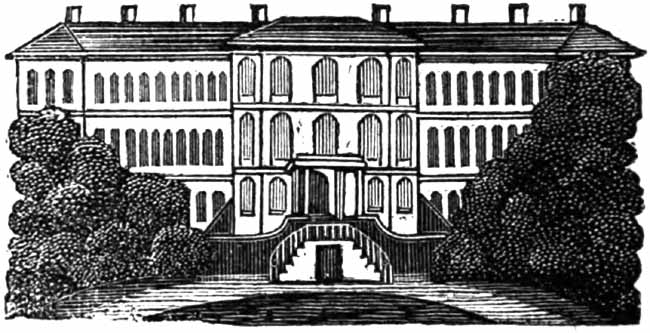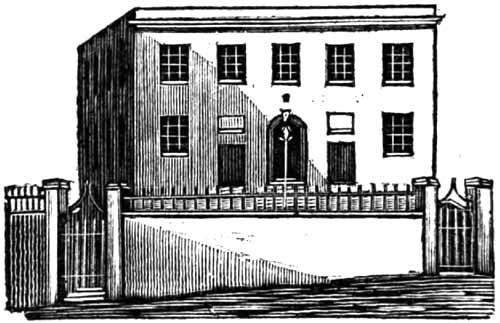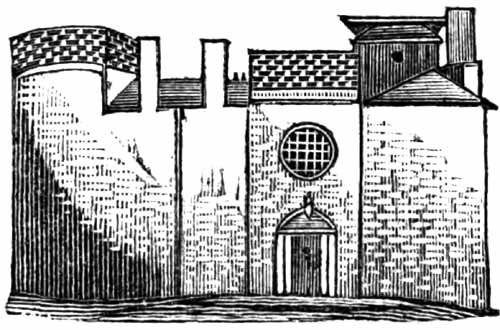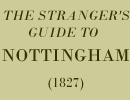< Previous | Contents | Next >
On the east of this hospital is Pennyfoot-stile, a narrow opening, which leads to a delightful walk to Snenton Hermitage, but as this is out of the town, and we cannot extend our perambulations quite so far, we must turn up Water-street, along Carter-gate and Old Glasshouse-lane, and leaving New Snenton to the right hand, we go up Carlton-road, where is erected a modern and spacious brick building, designated the

GENERAL LUNATIC ASYLUM,
for the town and county of Nottingham. The foundation of this extensive and well-constructed public building, was laid on the 31st of May, 1810, and it was opened for the admission of its unhappy tenantry, on the 12th of February, 1812, having cost nearly £20,000; and it is an humiliating consideration to human nature, that its wards are generally full of patients. There are extensive courts, gardens, and places for recreation, and the whole econo. my of the place is conducive to the welfare of its wretched inmates. The house director is Mr. Thomas Morris; the physician, Doctor Pennington, and the surgeon is Mr. Henry Oldknow.—We must now turn back towards the town, and crossing the corner of a field, we come to Gedling-street, which conducts us to Hockley, at the top of which, on the left hand side, and nearly opposite Coalpit-lane, stands a mill, originally built by the celebrated Richard Arkwright; he had built one before, which was the first cotton mill erected in the world, but that being destroyed by fire, Mr. Arkwright built the present erection on the same site. It was afterwards converted into a worsted mill, and is now devoted to the manufacture of lace on the improved lace machine, which has been a mine of wealth to the town of Nottingham, and which the stranger should by all means endeavour to obtain a sight of.—Close to this mill, is

HOCKLEY CHAPEL,
belonging to the Wesleyan Methodist Connexion. This place was erected in 1782, and measures fifty-two feet nine inches, by fifty-one feet two inches. It is a handsome brick building, and has a large gallery. The services are at halfpast ten, three, and six, on the Sabbath, and at seven on Thursday evening.—Proceeding up Goose-gate, we turn along Broad-street, and here is another chapel, belonging to the General Baptists, and known by the name of the
BROAD-STREET CHAPEL.
The society that worships here, were formerly united with their brethren in Plumptre-place, but disagreeing on some points of church government, in 1817, a part of them, with their venerable minister at their head, the Rev. Robert Smith, separated from the church, and in the year 1818, built the present place of worship, where service is performed every Sabbath at halfpast ten, halfpast two, and six o'clock, and on Tuesday evening, at seven.— Pursuing our course along Broad-street, an opening to the right, called High-cross-street, leads us to the
NATIONAL SCHOOL.
This place was erected in 1804, for the use of a congregation of Calvinists, the Rev. Mr. Crockford being the minister, but some untoward circumstances occuring, the society was broken up, the congregation dispersed, and the place was afterwards sold, and some considerable additions being made to the building, it is now very usefully appropriated as a school on Dr. Bell's, or the national system, where a number of boys are gratuitously educated. The school is supported by a long list of voluntary subscribers, and by annual collections made at the different churches of the establishment. The master is Mr. Aldridge, who also officiates at clerk at St. Paul's church. Close by, at the corner of East-street, stands the
METHODIST SUNDAY SCHOOL.
This useful institution, which belongs to the Methodists of the New Connexion, was the first Sabbath school built in Nottingham, being erected in the year 1804, and here about two hundred boys, and the same number of girls, are regularly instructed on the Sabbath day. In Beck-lane, which is just behind, stands the noble mansion of Charles Lomas Morley, Esq. one of the Aldermen of the town, and also
WOOLLEY'S ALMS HOUSES,
where six poor persons are comfortably accommodated at the close of life, but the endowment is very small. The occupancy of the rooms is in the gift of the churchwardens of St. Mary. At the north end of Beck-lane, is St. John's-street, where are situate
BILBY'S ALMS HOUSES,
founded by William Bilby, in the year 1709. This building contains eight apartments, four on the upper and four on the ground floor, for the reception of eight poor persons, each of whom have a sixpenny loaf a week, and about two ton of coal and a Christmas box once a year. This charity is entirely in the hands of the corporation — Nearly opposite, a wall is already built to inclose the new town jail, and at the top of the street is the

HOUSE OF CORRECTION
for the town of Nottingham. The site of this building was formerly occupied by a convent of hospitallers of St. John of Jerusalem; hence it is sometimes called St. John's prison. These hospitallers held considerable estates in this town, of which they were deprived by Henry VIII. and they were given to the Corporation, who converted the convent into a house of correction, to which from time to time, great additions have been made at the expense of the town. In the year 1826, a tread mill was erected therein, the labour of which raises water from a spring, which supplies not only the prison itself, but also a tap, for public use, at the outside of the walls, which is much resorted to by the inhabitants of the neighbourhood.
